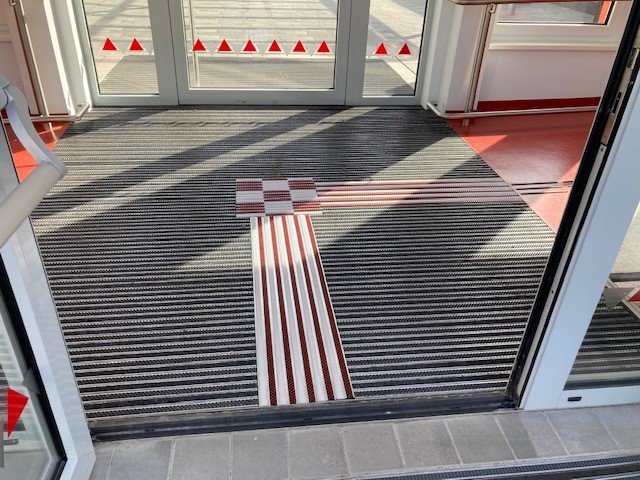Entrance mats with tactile guidance system: safety and accessibility combined
Entrance mats with tactile guidance systems play a central role in modern buildings. They not only protect the floor from dirt and moisture, but also ensure greater safety and accessibility. They serve as an orientation aid for blind and visually impaired people. Tactile elements enable independent and safe movement in the entrance area. By integrating them into the flooring concept, a visually appealing design is achieved in addition to functionality.
Function and structure of entrance mats with tactile guidance system
The main task of these mats is to fulfill two requirements at the same time: They keep the entrance area clean and provide safe orientation for visually impaired people. Tactile entrance mat systems consist of aluminum profiles with brushes and rubber inserts. These materials provide a non-slip grip and absorb dirt that could be carried into the interior. The tactile strips on the surface are specially designed for the long cane of blind people and can be easily felt with the feet.
Their robust design makes them ideal for high-traffic areas such as train stations, airports and shopping centers. The mats are weather-resistant and can be used both indoors and outdoors.

Possible applications for entrance mats with tactile guidance system
Entrance mats with tactile guidance systems can be used in many buildings. Here are a few examples:
Public buildings: They are indispensable in town halls, courts and libraries. They make it easier for blind and visually impaired people to access these facilities. At the same time, they contribute to the cleanliness of the building.
Train stations and airports: In areas with a high volume of people, it is important to make it easier for visually impaired people to find their way around. Tactile entrance mat systems are a particularly effective solution here. They offer safety and protection against soiling.
Shopping centers and stores: Here, too, the mats fulfill a dual function. They help visually impaired customers to move around the entrance area safely and prevent dirt from being carried into the entrance area.
Educational institutions: Universities, schools and other educational institutions rely on entrance mats with tactile guidance systems to ensure that all visitors can enter the building safely and without barriers.
Office and administration building: Here, aesthetics and functionality must go hand in hand. These mats offer a solution that is both visually appealing and meets the high standards of cleanliness and safety.
Technical details and customization options
Entrance mats with tactile guidance systems are not only practical, but also visually customizable. The aluminum profiles can be powder-coated in various RAL colors. These color options allow architects to seamlessly integrate the mats into the existing building design.
In addition to the choice of colors, special sizes and shapes are also possible. Whether round or square entrance areas, the mats can be tailored precisely to the needs of the building in question. Sound-absorbing rubber inserts also ensure that the mats generate less noise when walked on - an important factor in noise-sensitive areas such as hospitals or libraries.
Standards and accessibility according to DIN 18040-1
Our entrance mats with tactile guidance systems meet the requirements of DIN 18040-1, which defines the standards for barrier-free construction. This standard is particularly important for public buildings in which people with and without disabilities should be able to move around safely and independently. The tactile guidance systems support accessibility and make rooms safely accessible for visually impaired people.
Benefits for operators and planners
In addition to the obvious improvement in accessibility, these entrance matting systems also offer economic benefits. The dirt-trapping effect reduces the amount of cleaning required inside the building, which leads to lower maintenance costs in the long term. The increased safety also minimizes the risk of accidents such as slipping or tripping.
The mats are low-maintenance and easy to clean. Thanks to their robust materials, they retain their shape and functionality for years, even under heavy use. This makes them an economical and sensible long-term investment for any building.
Design and integration into the architectural concept
Another advantage is the ability to customize the design to the building. Entrance mats with tactile guidance systems can be designed in terms of color and structure so that they are not only functional, but also enhance the overall concept of the entrance area. The high-contrast use of colors can make tactile guidance strips highly visible, which enhances the visual and haptic effect.
The profiles can be used both indoors and outdoors without compromising on quality or function. Their weather resistance makes them ideal for use at heavily frequented entrances that are frequently exposed to rain, snow or dirt.
Conclusion: Entrance mats with tactile guidance system - the perfect solution for safe entrance areas
Entrance mats with tactile guidance systems offer an ideal combination of safety, cleanliness and accessibility. They are suitable for a wide range of buildings and can be adapted to individual requirements. Whether in public buildings, shopping centers, train stations or office complexes - these mats help people with visual impairments to find their way around safely and independently.
Thanks to the use of high-quality materials and the possibility of individual customization, they offer a durable and economical solution for heavily frequented entrance areas. Architects and planners can rely on the quality and flexibility of rotec entrance matting systems.
Get in touch with us
Would you like to find out more about our entrance mats with tactile guidance system? Visit our website or contact our team of experts. We will be happy to advise you on the planning and implementation of your projects.
Further information on entrance mats:
Anna Osiewala
Mail: a.osiewala@rotec-berlin.de
Phone: +49 30 789039-15




